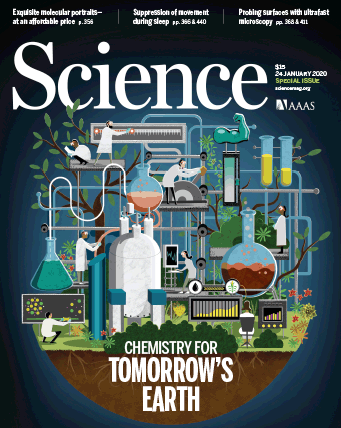Jan 27 2020
The latest issue of the academic journal Science includes a case study for a future where the chemicals and materials that form the basis of the economy and society are renewable rather than depleting, healthful rather than toxic, and degradable rather than persistent.
 The January 24th, 2020, issue of Science features green chemistry and its importance for a sustainable future. Image Credit: Yale School of Forestry & Environmental Studies.
The January 24th, 2020, issue of Science features green chemistry and its importance for a sustainable future. Image Credit: Yale School of Forestry & Environmental Studies.
An article titled “Designing for a Green Chemistry Future” of this issue offers a vivid picture of that future. This article has been written by a team of researchers at Yale.
The team includes Julie Zimmerman, professor of green engineering and senior associate dean of academic affairs at F&ES; Paul Anastas, the Teresa and H. John Heinz III Professor in the Practice of Chemistry for the Environment at F&ES; and Hanno Erythropel, an associate research scientist at the Center for Green Chemistry & Green Engineering at Yale.
Walter Leitner, a leading person in green chemistry and a professor at the Max-Planck Institute for Chemical Energy Conversion in Germany, was also one of the members of the research team.
The basic idea is that green chemistry should be the basis of how we do any kind of chemistry in the future.
Hanno Erythropel, Associate Research Scientist, Center for Green Chemistry & Green Engineering at Yale
He described that, quite often, the assessment of chemicals and the procedures used to develop these focus mainly on how effectively they work. However, they fail to include concerns about their potential effects during the entire life cycle. Systems thinking ought to be used in chemical production to produce sustainable, nontoxic, and recyclable chemicals, right from the design stage, through production and use, to disposal.
In the article, the researchers assert that the errors of the chemical industry in the past need not be replicated in the future, which is proven by innovation and advanced research in green chemistry.
They emphasize how achievements in green chemistry have already started the process of reinventing all things from agriculture to electronics, plastics to pharmaceuticals, energy generation and storage, and much more. So far, the achievements are convincing but, as stated by Anastas, these are only the beginning.
The astounding accomplishments of green chemistry and green engineering thus far pale in comparison to the power and the potential of the field in the future.
Paul Anastas, Teresa and H. John Heinz III Professor, Practice of Chemistry for the Environment, Yale School of Forestry & Environmental Studies
There are several examples of green chemistry boosting economic profits while still being positive for human health, sustainability, and the environment. However, it is still the exception and not the rule.
Sustainability requires that green chemistry and green engineering be done systematically, so that it is simply the way all chemistry is done in the future.
Julie Zimmerman, Professor of Green Engineering and Senior Associate Dean of Academic Affairs, Yale School of Forestry & Environmental Studies